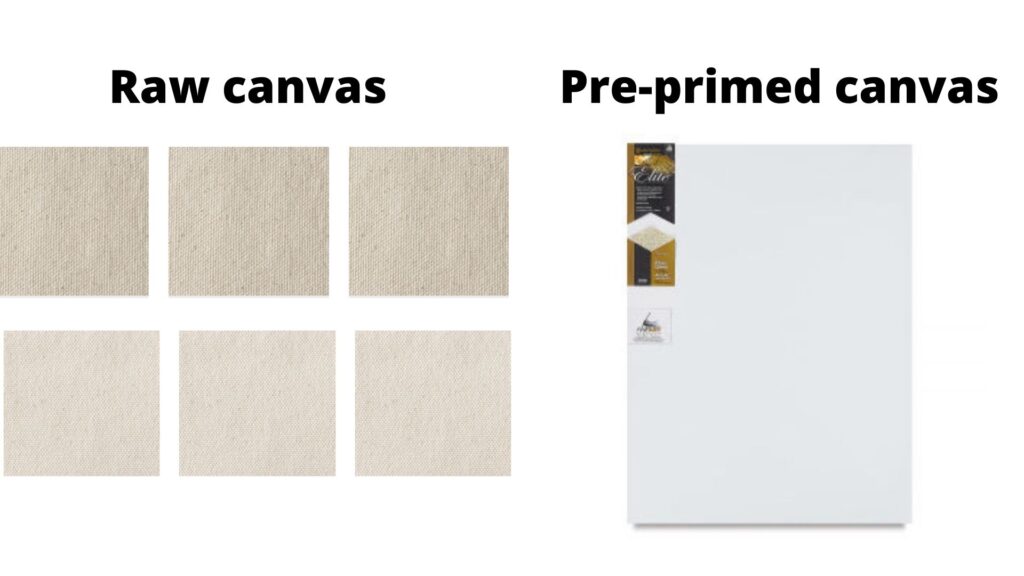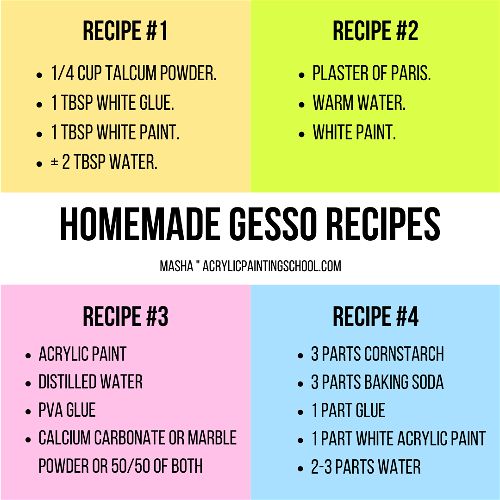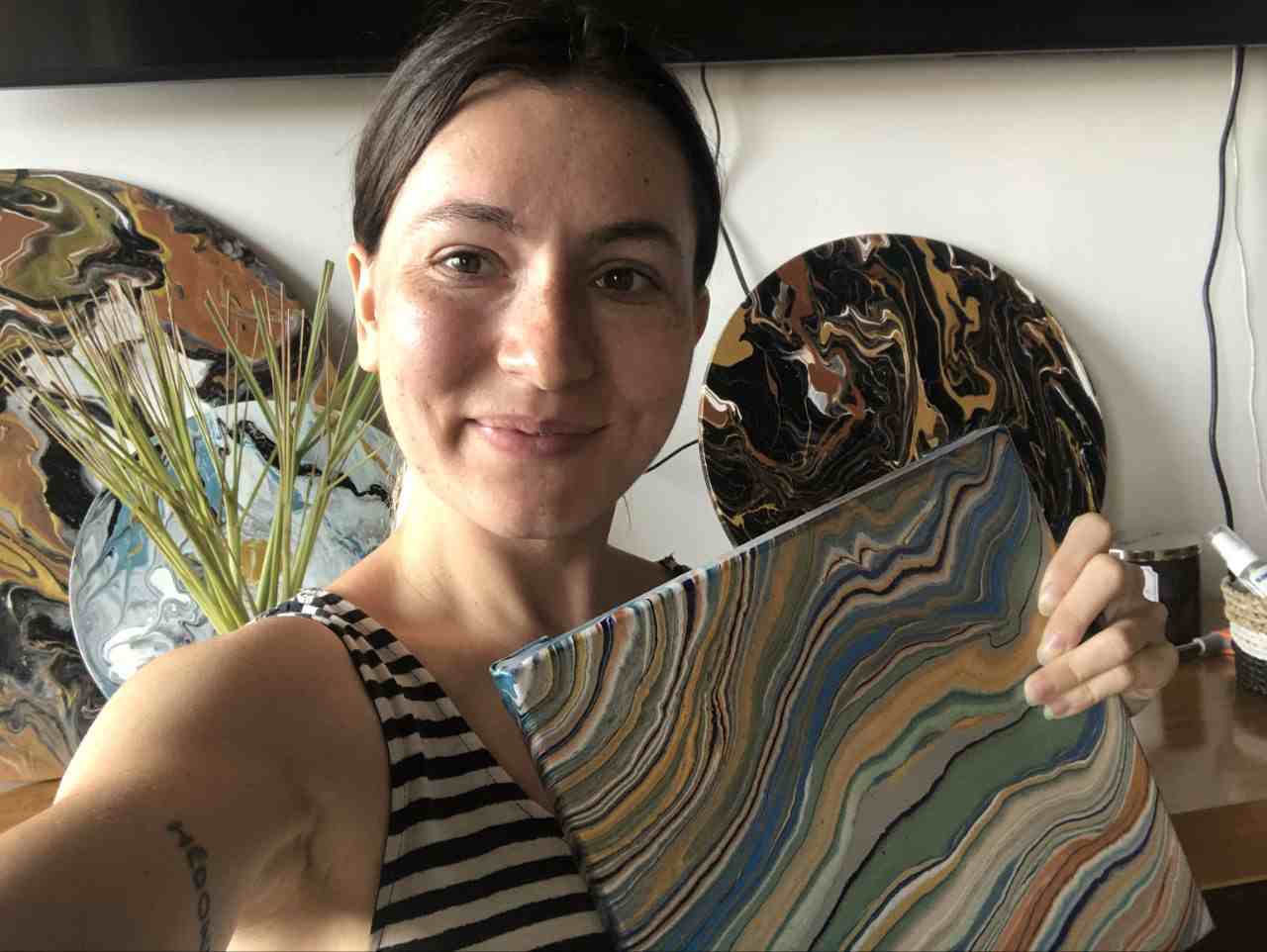Last Updated on April 1, 2024 by Masha Eretnova
Gesso is something many beginners try to understand. While professional artists blend it and share homemade recipes, beginners just want to know what is this and if they need it or not?!
The decision is gesso necessary for acrylic painting depends on the surface you work with. You don’t have to gesso a pre-primed canvas purchased in a craft shop, but even if you need it, you can make a Homemade Gesso easily. The gesso is necessary for raw canvas, wood, and other surfaces because it provides paint adhesion.

I’d like to guide you in this article to common reasons why we use gesso for acrylic painting, my easy instruction on how to do it, but also how we can make it at home or where to buy the recommended brands for the best prices.
Table of contents:
- ⏩ What is gesso?
- ⏩ The 2 main reasons Why gesso is necessary for acrylic painting
- When the gesso is not necessary
- How to apply gesso
- Tips to paint with gesso
- 11 affordable acrylic gesso
- ⏩ 4 Homemade gesso recipes
This article contains affiliate links. It means no extra cost for you but a little commission (2-3%) for me to support my hobby and blog. Thank you!
What is gesso?
- Fluid in nature
- Reduce viscosity of heavier paints and gels
- Includes 32-oz / 946ml bottle of medium
- Intermixable with Liquitex Professional Acrylic Paint Colors and Mediums
- Conforms to ASTM D4236; Safe for educational use
Gesso is a primer to get your canvas ready for painting. Gesso isn’t just white acrylic paint. Modern acrylic gesso is a combination of:
- Acrylic polymer medium (binder)
- Calcium carbonate (chalk)
- A pigment (usually
Titanium white ) - Chemicals that ensure flexibility and long archival life
Acrylic gesso doesn’t contain glue!
You can buy gesso readymade from any art supply shop or you can make your own, homemade gesso. You’ll find the list of recommended gesso and 3 homemade recipes in this article.
The main function of gesso is to prepare (or “prime”) the surface for painting, making the surface slightly textured and ready to accept acrylic paint. The gesso can be applied to nearly any surface, and then you can paint on that surface with acrylic paint.
Without gesso, the canvas will just soak all paint.
The word gesso is a noun, but many artists also use it as a verb. For example: "You need to gesso your canvas before you paint."
2 gesso grades: student and artist
The difference between the two grades is the amounts and different ratios of pigment vs. filler, which affects price and quality.
| Student grade | Artist-grade |
| Composition: more filler, less pigment. Fine with pre-primed canvases. Price: cheaper Products: e.i. Liquitex Basics Gesso Surface Prep | Composition: more pigment, thicker, more opaque. Good for raw and primed canvases. Price: more expensive Products: e.i. Liquitex Acrylic Gesso |
The consistency and texture of gesso will vary from brand to brand. Some brands put “heavy” in the name of the gesso. The only way to find your ideal gesso is to try!
Gesso colors
The most common and traditional color is white. Today some brands also sell colored, black or clear options.
E.i. Holbein Acryla Colored Gesso has 21 colors in its chart:

In fact, you can add some acrylic paint to your gesso and make it any color you want.
Gesso forms
- bottles
- tubs
- jars
- spray
What form is better for you? There is no rule on which forms to use. Feel free to choose whatever is more comfortable for your work personally.
E.i. you can squeeze bottled gesso or a tub directly on your canvas and use a brush to smooth it. With a jar you don’t have to pour it, you can just deep brush into the gesso.
When you use a gesso spray don’t forget to shake it before using. In this case, you even don’t need any brush but be careful and watch the homogeneous layer.
I’m very used to jars and bottles and I love them! In the Recommended product section below you’ll find some of my favorite but also very popular brands.
Why gesso is necessary?
Gesso is useful, easy to apply, dries quickly, and much cheaper than saving your cracked acrylic painting
- it smooths out the imperfections of the canvas,
- and it improves the adhesion between the paint and the canvas. Paint on raw canvas is more likely to crack and flake, it’s also hard to blend onto a raw material.
If you’re reading this after some bad experience of cracking or flaking on your acrylic paintings, don’t give up, you can definitely fix it with my easy step-by-step guide.
When the gesso isn’t necessary?
If you buy a pre-primed canvas in the art store, it already has a layer of gesso on it. It’s easy to tell if the canvas is pre-primed – it will be bright white or black.
Normally, all stretched canvas that you can buy in the art store is pre-primed. You can also see sometimes ‘triple primed’ – be sure, it’s a canvas of very good quality.
Gesso is a primer, that's why we call prepared canvas "pre-primed". Should you gesso a primed canvas? No, if you find it smooth enough.

However, sometimes you may feel that the canvas lacks tooth and absorbency, e.i. you start painting and you see that your canvas soaks paint or it’s patchy. In this case, I would highly recommend applying 1-2 coats of gesso.
Related post: Best Canvas for Acrylic Painting for Beginners that Professionals use
How to gesso a raw canvas for acrylic painting
What You Need:
- Gesso, the great one is artist Golden Gesso, but you can choose your own
- Brush
- OPTIONAL: 220-240-grit sandpaper if you want to sand the layers in between each other.
How to prime a canvas:
- Prepare your workplace and materials. If you have a jar or a tub for gesso, stir it.
- Apply the first coat with a brush. Use a wide, stiff brush. The bigger your surface, the bigger brush you will need. Work quickly.
- If you want to get more pigmented gesso, add acrylic paint
- If you need to play with texture, try to add some texture gel
- If you want to make gesso thinner and the layers more smooth, add some water
- Let it dry, then apply a second coat.
- To make a really smooth coat, use sandpaper to gently sand in between each layer. Wipe it off.
- Brush back and forth over the surface.
- Pop any bubbles.
- Once dry, sandpaper your surface slightly.
- Repeat steps 1-4 until the surface you prefer is obtained.
- Let it dry. For optimal results, the gesso is best left to dry overnight.
- Wash your brush out immediately in running water then use a brush cleaner to thoroughly remove the gesso. It’s worth cleaning it twice even if you think it’s clean.
How to gesso a wood panel for acrylic painting
Acrylic paint is great for many surfaces, wood is one of them. Remember that you don’t start preparing wood for acrylic painting with gesso.

Preparing the wooden panel includes sanding, sealing, and only then priming (gesso is a primer).
To follow the full guide on How to prepare the wood and don’t let your panel peel off, read my article How to prepare wood for acrylic painting.
Tips: For better results use a 4-6-inch foam roller that doesn’t have a nap or Krylon gesso spray.
Tips for everyone who works with gesso
For even more smooth coat and photo-realistic paintings:
- sand each layer with fine 240-grit sandpaper.
- use the brush and go over and over to make the gesso layer more even.
- if your brush leaves lines, use another dry brush and go over the canvas again.
- turn the canvas 90 degrees between coats to ensure even coverage.
- work from the top to the bottom of the canvas, in parallel strokes from one edge to the other.
The best consistency (thickness) for some artists – is a dense cream consistency
For brushes:
- clean them twice after applying gesso!
- don’t use cheap brushes! They leave bristles and lines and could really damage your surface.
Certain modern styles actually benefits from painting directly onto a raw canvas!
Recommended products
| Name | Grade | Price | Size |
| Golden Acrylic Gesso | Artist | $9.71 – $61.55 | 8 oz – 128 oz |
| Blick Professional Acrylic Gesso | Artist | $29.27 – $53.19 | 32 oz & 128 oz |
| Liquitex Basics Gesso Surface Prep | Student | $4.94 – $32.33 | 8,5 oz – 128 oz |
| Liquitex Acrylic Gesso (4 colors available) | Artist | $10.99 – $69.99 | 4 oz – 128 oz |
| Sargent Art Gesso | Student | $17.61 | 32 oz |
| Handy Art Gesso (2 colors) | Student | $13 – 37.5 | 16 oz – 128 oz |
| Winsor & Newton Artists Acrylic Gesso | Artist | $10.55 – $25.19 | 8 oz – 32 oz |
| Krylon Gesso Spray | N/A | $9.65 | 11 oz |
| Old Holland Gesso (5 colors available) | Artist | $28.25 – $41.95 | 500 ml & 1L |
| Prima Marketing Gesso | N/A | $10.97 | 8,5 oz |
| Holbein Acryla Colored Gesso | Artist | $19.99 – $49.08 | 300 ml |
| Utrecht Professional gesso (not Artist) | Artist | $30 to $66 | 500 ml or 4 kg |
4 Homemade gesso recipes
Homemade gesso is cheaper to produce and can be adjusted to personal needs, however, it’s not needed when you are first starting painting. The readymade gesso isn’t expensive, prices start at 5$ for 8,5 oz.

Personally, I prefer to save time for painting itself and just buy a gesso. I’ll share with you common artists’ recipes but remember that this is a sort of experimenting and there is no guarantee of stability, especially with powder, plasters, and other things, because they are never used by manufacturers.
Amounts are very approximate, it’s all your personal needs and preferences.
Homemade gesso – Recipe #1
Ingredients:
- 1/4 cup talcum powder.
- 1 tablespoon white glue.
- 1 tablespoon white paint.
- water to desired consistency. (around 2 tablespoons)
Mix until homogenous consistency and apply onto canvas.
Homemade gesso – Recipe #2
Ingredients:
- Plaster of Paris
- Warm water
- White paint or any other color if you want your gesso to be tinted.
Mix equal parts of sifted Plaster of Paris and warm water. Stir. Add white paint or a different color. Stir again. Apply!
Homemade gesso – Recipe #3
Ingredients:
- Acrylic paint
- Distilled water
- PVA glue
- Calcium carbonate or Marble powder or 50/50 of both
Mix acrylic paint with distilled water and stir until it has a creamy consistency. Add a bit of PVA glue (something around 1/5-1/6 of the paint amount). Add some calcium carbonate (the amount depends on how chalky you want your gesso to be). Mix it very well! If it’s too thick, add water. It’s done and you can keep it up for a couple of years.
Homemade gesso recipe #4
- 3 parts cornstarch
- 3 parts Baking Soda
- 1 part glue
- 1 part white acrylic paint
- 2-3 parts water
Water regulates how thick the gesso is, so feel free to add a little bit more or less, depending on what you like.
Read also: Try 15+ Gesso Alternatives Or Make Your Own Cheap Gesso (6 more recipes)
Conclusion
You are at the beginning of your creative journey, don’t overthink. Experiment with pre-primed canvases and be more focused on the basics of painting. Take notes and follow your artistic intuition. Feel free to use my guides!
If you are ready to start painting, get straight to my ultimate painting guide: How to Use Acrylic Paint: 3 Easy Steps To Paint With Acrylics On Canvas

Masha Eretnova, born in 1991, is a Buenos Aires-based certified teacher, artist, and member of the Professional Artist Association with 20+ years of personal painting journey.
She started painting and drawing very early and is now an international abstract artist and educator passionate about acrylic painting, gouache, and crafts.
Her works are part of international exhibitions and contests, including ArtlyMix (Brazil), Al-Tiba 9 (Spain), Exhibizone (Canada), Italy, and many more.
Besides her artistic pursuits, Masha holds a post-grad diploma in Teaching Film Photography and 2 music school diplomas: piano and opera singing.
Last update on 2024-07-26 / Affiliate links / Images from Amazon Product Advertising API
